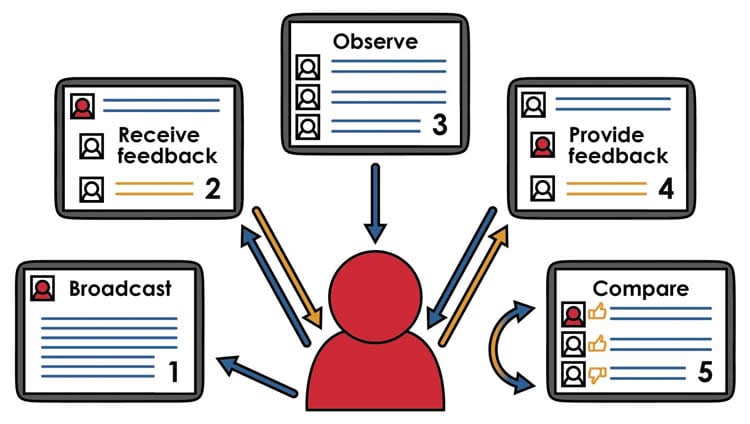Because social media is used so pervasively in modern society to tap into people’s behaviors and thoughts, neuroscientists are finding Facebook, Twitter, and other platforms to be very useful tools in a broad range of research areas. A review published November 11 in Trends in Cognitive Sciences describes some of the approaches that neuroscientists can use to gain valuable insights from social media and highlights some of the questions that might be answered by social media-based studies.
“Neuroscience research with social media is still in its infancy, and there is great potential for future scientific discovery,” says co-lead author Dar Meshi of Freie Universität in Berlin. “The sheer number of people using social media is enormous, and continues to increase, with some people spending several hours on social media each day.”
In their review, Meshi, Diana Tamir, and Hauke Keekeren note that neuroscientists can take advantage of similarities between online and offline behavior–essentially using measures from online social media use as a proxy for real-world social behaviors. For example, a social media user’s broadcasts can be analyzed to measure his or her emotional state. Also, by examining changes in a user’s broadcasts after exposure to friends’ broadcasts, social media can be used to measure social conformity. How people scroll through social media newsfeeds and click on content can provide insights into users’ curiosity, and their digital footprint on social media may offer clues to their personality traits. Also, how people interact within their social network might be used as a proxy for their offline social interactions.
Alternatively, neuroscientists can capitalize on the differences between online and offline social environments and investigate brain structure and function in light of these differences. For example, during face-to-face discourse, people spend approximately 30% of conversations sharing information about themselves; however, online, where people have limitless opportunities to share information, such self-disclosure skyrockets to comprise 80% of online posts. Furthermore, politeness norms dictate that people should behave cordially to one another in face-to-face interactions, but the social distance provided by certain social media platforms can violate these norms.
“By releasing people from some of the environmental constraints that usually shape their behavior, social media provides a wellspring of opportunity to understand the roots of our social behaviors and the extent to which they will be influenced by different environmental factors,” says co-lead author Diana Tamir, of Princeton University. “Neuroscientists can capitalize on these natural variations in online environments by collecting behavioral data and relating them to brain structure or function to ask new questions about the roots of our social brain and how it adapts in new environments.”
Some limitations to using social media in research include the possibility of “self-presentation biases,” because people are highly aware of how they present themselves to the online world. Also, there are potential privacy and ethical concerns. For example, if a consenting participant posts a picture on Facebook and a friend comments on it, researchers may be able to download the identity of the friend and the content of the comment, potentially breaching the friend’s privacy.

Meshi notes that apart from being used as a research tool, social media must also be a subject of scrutiny. As social media use continues to increase, it will be important to study its positive and negative effects on people, especially children and adolescents, who make up a significant portion of users.
“Though social media can elicit positive consequences, exploring the effects of social media on the brain is especially relevant considering that social media use can disrupt normal functioning, such as contributing to poor academic performance, job loss, and declines in wellbeing,” Meshi says.
Funding: Funding was provided by the German Research Foundation.
Source: Joseph Caputo – Cell Press
Image Source: The image is credited to Meshi, Tamir, and Heekeren/Trends in Cognitive Sciences 2015
Original Research: Abstract for “The Emerging Neuroscience of Social Media” by Dar Meshi, Diana I. Tamir, and Hauke R. Heekeren in Trends in Cognitive Sciences. Published online November 11 2015 doi:10.1016/j.tics.2015.09.004
Abstract
The Emerging Neuroscience of Social Media
Social media use is a global phenomenon, with almost two billion people worldwide regularly using these websites. As Internet access around the world increases, so will the number of social media users. Neuroscientists can capitalize on the ubiquity of social media use to gain novel insights about social cognitive processes and the neural systems that support them. This review outlines social motives that drive people to use social media, proposes neural systems supporting social media use, and describes approaches neuroscientists can use to conduct research with social media. We close by noting important directions and ethical considerations of future research with social media.
Trends
Social media use is a global phenomenon. Neuroscientists are beginning to capitalize on the ubiquity of social media use to gain novel insights about social cognitive processes.
Social media provide platforms for users to satisfy fundamental social drives, such as connecting with others and managing one’s reputation with others.
Neural systems that support various types of social cognition have been established by research with offline behaviors. These neural systems should be involved in online social media use.
Neuroscientists can take two approaches when using social media in research. They can take advantage of similarities between on- and offline social behaviors, using measures from social media as a proxy for offline behaviors. Alternately, they can capitalize on differences between the on- and offline world, investigating behaviors unique to the online environment.
“The Emerging Neuroscience of Social Media” by Dar Meshi, Diana I. Tamir, and Hauke R. Heekeren in Trends in Cognitive Sciences. Published online November 11 2015 doi:10.1016/j.tics.2015.09.004






